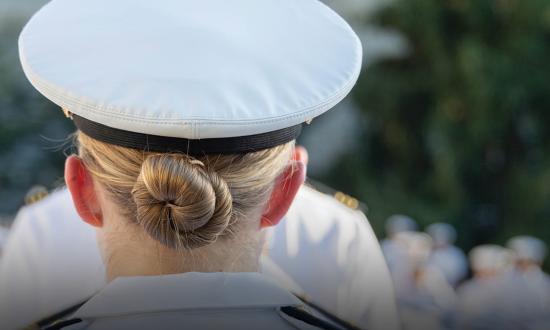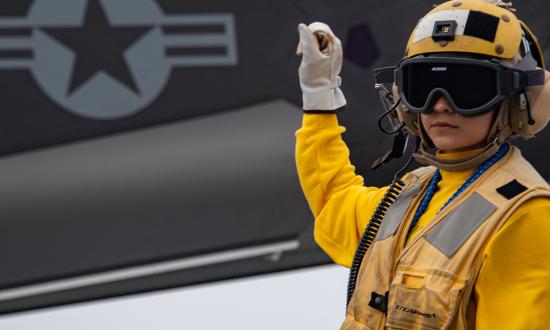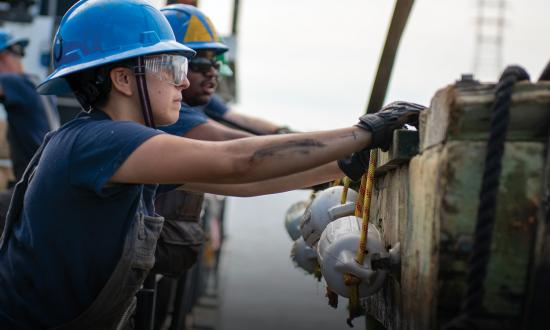In the post–war on terrorism years, service members’ ability to coexist and build camaraderie has been tested. The Marine Corps has not been exempt, and in the area of gender-integrated training, there is a schism. As discussion of male and female recruits training side by side has arisen, there has been a parting of the ways in theories of application. The decision and reforms implemented now will shape the future of Marines and their ability to look beyond gender norms. Further integration of men and women at recruit training will benefit relationships among Marines, modernize the training process, and fulfill what the National Defense Authorization Act and current doctrine demand.
Every individual who dons the eagle, globe, and anchor is a warfighter first. This identity transcends titles and military occupational specialties; it is how Marines build commonality among differing cultures and economic backgrounds. This bond has been successful in many areas, but it has fallen short in how men and women in the Marine Corps view each other’s roles.
For decades, gender division has started as soon as a Marine steps on the yellow footprints at Parris Island or San Diego. This segregation is necessary, as these young men and women are still civilians who have yet to comprehend the Marine Corps’ core values or how to adopt them in their daily lives. But at what point in recruit training do male and female recruits find themselves side by side fighting for the same goal?
In the current integrated model—a training company of six platoons, of which four are men and two are women—it might occur directly before the Crucible, if at all. Company commanders currently are the driving force, and they have differing views on integration and what it should look like. Too many are risk averse or simply do not believe in integration.
During my time as a chief drill instructor at Second Recruit Training Battalion, Echo Company, for three training cycles, we pushed the limits of what was acceptable, consistently asking permission to further integrate as the training cycle progressed. Group physical training sessions were integrated by the second month, and basic warrior training was integrated at the fire team level for multiple events. These decisions raised eyebrows and often were scoffed at by other integrated companies. What we universally saw, though, was that during “Marine weeks,” our company was able to coexist and work together to accomplish dynamic tasks.
The common fear with integration is sexual interaction, but that did not occur, nor were there rumors of such activities among the recruits. Not that it would be impossible or incomprehensible, but our theory was if we started integration earlier, it would not be such a shock later in training.
We did all this in hopes of strengthening the bonds between men and women and furthering that connection in the fleet Marine force. In any future battlespace, cooperation and companionship among all Marines will be paramount. The Marine Corps cannot succeed in future conflicts if the gender gap continues on its current path. By closing this gap inch by inch in recruit training, we increase the likelihood for success thereafter.
History Repeated
The makeup of a platoon in recruit training is representative of a small unit in the fleet Marine force. Individuals of all races, creeds, and religions work together for a common goal. The missing term in that statement is gender. Retired service members and prominent Marine Corps officers would argue that the omission is vital to Marines’ survival. Until 26 July 1948, that same mindset fought against black and white recruits training together.
President Harry Truman’s Executive Order 9981 forced the Marine Corps to change.1 Many at the time assumed it would be the downfall of the Marine Corps, but it only improved the service’s warfighting capabilities and famed brotherhood. Freshly integrated African American Marines fought bravely alongside their fellow Marines and became fighter pilots in the Korean War.
Greater gender integration in recruit training could have the same positive effect, not only in the battlespace, but also on the Marine Corps’ image. After being in charge of female recruits, I saw this positive impact firsthand.
Learning Together
In spring 2020, because of a manning issue, I had the privilege of being a drill instructor with a female platoon. Taking over a training platoon mid-cycle is never easy, and adding that I had never directly trained women before made it a tad unnerving. For the next two months, the recruits learned from my perspective, and I learned from theirs. Together we cultivated an identity and idea that turned many heads on Parris Island, but the platoon flourished and built esprit de corps.
The logistical pieces were easily worked through, and never once was I or any of the recruits made to feel uncomfortable. In that training cycle, we quickly figured out how to have a male drill instructor train female recruits. They were grateful for the experience, and so was I.
Unfortunately, this occurred in a bubble and has yet to be repeated. Although I and others have tried, commanding officers consistently have denied drill instructors the opportunity to integrate their teams. If recruits do not see their drill instructor teams working together as men and women, what message does this send? If the Marine Corps does not trust noncommissioned officers and staff noncommissioned officers of different genders to conduct themselves appropriately and effectively, there is no one to set the example.
The formula for not only coexisting but also thriving is not one that can be developed right before leaving the line of departure in some austere environment. It must be mastered where Marines are made and expected to adopt the warfighting way of life.
Change or Be Changed
The 2020 National Defense Authorization Act turned up the pressure for integration, and eventually it will be demanded at the platoon level.2 The only choice will be whether the Marine Corps changes on its terms or those dictated by Congress.
The service can continue to drag its feet, but establishing one or two female platoons in a company will not suffice. Admittedly, there are not enough female recruits to integrate every training company at Parris Island and San Diego, and this likely will not change anytime soon. However, the companies that are integrated must walk a fine line between what is and is not allowed. Force Design 2030 calls for “transformative innovation” and “resizing, reshaping, and reequipping” the force.3 It is illogical to think this document created to foster an adaptable and relevant force does not apply to recruit training and integration.
The strength of the individual Marine is the backbone of the service, but that strength is tied to the bonds among Marines. The service should not weaken those bonds for the sake of tradition or outdated thinking. Evolution must occur for organizations to endure. Further integration must occur in the Marine Corps to create a service in which individuals are seen for their ability to perform in combat rather than their gender.
1. Harry S. Truman, Executive Order 9981: “Desegregation of the Armed Forces” (Washington, DC: The White House, 26 July 1948).
2. Philip Athey, “The Marines Likely Won’t Gender-Integrate Boot Camp at the Platoon Level,” Marine Corps Times, 8 February 2022.
3. Gen David H. Berger, USMC, Force Design 2030 Annual Update (Washington, DC: Headquarters U.S. Marine Corps, April 2021).







